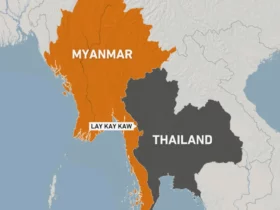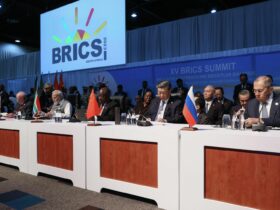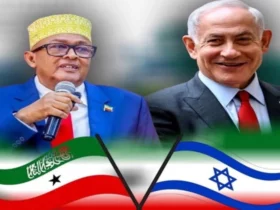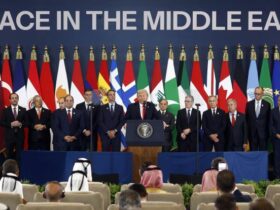By Orçun Göktürk *
Terms contain a great historical-scientific and even class distinction. The Biden administration continues the same “Indo-Pacific” rhetoric that the US officially changed during the Trump era. Of course, some might say that there is a geographical difference between the two. But the nightmare of the American political elites, the “Asian Age in the 21st Century”, also manifests itself in the narrative. “Asia”, today symbolizes the birth of a new civilization, which the Atlantic alliance avoids even at a simple level. Geographically considered, the term “Asia-Pacific” was already used to refer to the regions bordering the Pacific and Indian Oceans.
The situation gradually changed when Japanese Prime Minister Shinzo Abe, who was assassinated last year, first coined the term “Indo-Pacific” in the political arena in 2007 The pro-Atlantic side showed its inclination towards the US geostrategic agenda in regards of India and the region. With the Trump administration, the region is now fully referred to as the “Indo-Pacific”. (1) “Open and Free Indo-Pacific” has become the official US rhetoric against the People’s Republic of China and Asian countries that have re-emerged as a major power in the region.
The strategic importance of the Pacific for the US and China
The Asia-Pacific region, stretching from the US Pacific coastline to the Indian Ocean, is home to more than half the world’s population and nearly two-thirds of the world economy. More members of the US military are stationed in the region than in any other country outside the United States. The region supports more than three million American jobs and is the economic lifeblood of the imperialist power, being the source of nearly $900 billion in foreign direct investment in the United States. (2)
Asia-Pacific is rich in mineral reserves, including 35% of global natural gas, 67% of oil reserves, 40% of gold reserves, 60% of uranium reserves and 80% of diamond deposits. Another strategic importance of the region can be seen in the fact that it hosts seven of the world’s ten largest armies, six nuclear powers and contributes to two-thirds of world GDP growth.
The region is also critical, especially for China, which has undergone a miraculous economic development over the last 40 years and is increasingly in need of energy resources (it is the main route for China’s oil supplies and 85% of China’s oil imports pass through the Strait of Malacca).
‘Pawns of US hegemony’
In an interview with the media last year, Wang Yi, a member of China’s State Council and former foreign minister (he is currently the chairman of the Central Foreign Affairs Commission of the Communist Party of China, the most senior diplomat in China), stated that the United States was “trying to surround China” with the “Indo-Pacific” rhetoric and that it was “doomed to fail”. The top Chinese diplomat also described the US use of “Indo-Pacific” instead of “Asia-Pacific” as “against the peoples of Asia who have a common future” and emphasized that the US was “trying to turn Asia-Pacific countries into ‘pawns’ of US hegemony” and “undermining the peace and development promoted by the countries of the region through decades of joint efforts.” (3)
Impact of Russia’s special military operation on Asia-Pacific
The Russian Federation’s military operation against the pro-NATO regime in Ukraine, launched in February last year, has brought about a historic break both regionally and internationally. For the US, it created an opportunity for consolidation within Europe, the G7 and the old-era collective imperialist partnership, but it failed to create a de facto anti-Russian network of allies in Asia, Africa and South America-Caribbean (in the developing world, which constitutes the crucial majority of the world). In fact, with the majority of countries in West Asia, Latin America, the Arab world and Africa not participating in the anti-Russian sanctions, American foreign policy makers have begun to say, “we need to change our strategy in Ukraine.” (4)
In terms of world geopolitics, Russia’s fight against NATO and its pawns in Ukraine has benefited the Asia-Pacific region the most. From the Taiwan card to the disputed island between Japan and Russia, the US and its allies have for a considerable period of time relegated imperialist aggression in the Pacific to a secondary position in their strategy to surround China, to the point where the US and its allies cannot imagine opening a second front.
In the Pacific, the United States is nonetheless pursuing its strategy of revitalizing old partnerships at the highest level. Japan, the world’s third largest economy, has long kept its military budget at 1 percent of GDP, but has decided to change that starting in 2023. Tokyo has decided to double its military budget for 2023, citing “China’s growing threats, North Korea’s nuclear and missile programs, and the changing geopolitical environment following Russia’s invasion of Ukraine.” (5) On the other hand, the leaders of Japan and South Korea met twice in less than two months, which was interpreted by Chinese media as “part of the US effort to form a bloc against China.” (6)
In the South China Sea, the US is once again attempting to increase pressure on China through the Philippines. After the US reopened its embassy in the Solomon Islands after 30 years, the US reopened 5 military bases in the Philippines and even announced the opening of 4 new military bases, making a total of 9 American military bases operational. It is rumored that three of the new bases will be located on Luzon Island. Luzon Island is in a strategic position as it is the largest piece of land close to Taiwan after the Chinese mainland.
‘All that is solid melts into air’
On the other hand, after Xi Jinping’s third term began, he presented himself again and again in Moscow with a pose of “unwavering friendship” with Putin, the step-by-step defeat of imperialist aggression in Syria and Syria’s return to the Arab League, and the shameful escape of the US from Afghanistan after 20 years of occupation, the peoples and states of the world began to change their new foreign policy engagements as they witnessed factually the change in the unipolar structure of the international order. The Chinese-brokered meeting between Saudi Arabia and Iran in Beijing led to comments in the West that “we are losing the initiative even at the table.” (7)
Meanwhile, we have witnessed the US attempt to revitalize the Atlantic alliance in the Pacific (QUAD), which the Biden administration inherited from Trump, the AUKUS Agreement with Australia, the increased risk of border disputes and military confrontation between China and India from June 2020, the rise to power of more pro-US parties in Japan and South Korea (of course the message to Japan with the Abe assassination), the reckless policies of the separatist Tsai Ing-wen administration in Taiwan. The Rand Corporation report “Regional Responses to U.S.-China Competition in the Indo-Pacific”, published a few years ago, also notes the U.S. efforts to increase Japanese influence in the Association of Southeast Asian Nations (ASEAN). (8)
Loyalty to the Atlantic alliance does not involve “unwavering friendships”, but rather “collaborations”, most of which are maintained by the power of “force”. This “force” includes the following: The network of semi-permanent overseas military bases established by the United States around the world during and after the Second World War was, in the words of Stephen Krasner, “unparalleled in history; never before had a state deployed its troops in such large numbers in the sovereign territory of other countries for such a long period of peace.” (9)
Marx’s aphorism “All that is solid melts into air”, stated 150 years ago in the middle of major political and economic transformations in Europe, still remains valid for the international system today. While the main perception of US imperialism is still the Ukraine issue and the deployment of troops in Europe, it continues its strategy of containing China in the Pacific. Ahead of the G7 summit to be held in Hiroshima on May 19-21, Japanese leader Kishida, who holds the G7 term presidency, became the first leader to visit the Republic of Korea (South Korea) in the last 5 years by visiting Seoul after a week-long tour of Africa. Although Kishida’s relations with Seoul are burdened with issues that are difficult to resolve in the short term, such as “forced Korean laborers” and “abused Korean women” in 1910-1945, there is talk that Japan may invite South Korea to the G7 summit as an observer, as the US is pushing the two countries to ally against China.
On the other hand, another development that strained relations between South Korea and China came from the Korean peninsula. The South Korean Embassy in China sent a letter lodging a “formal protest” in response to various reports and articles published by the Global Times, the English-language publication of the CPC’s People’s Daily, about South Korean President Yoon Suk-yeol’s visit to the United States last week. The Global Times responded to Seoul’s protest by saying, ” Such words that crossed boundaries and came with strong emotions should not come from a diplomatic institution. We cannot accept the rather brutal interference in our independent reporting, and we find it difficult to agree with the views and accusations against our newspaper in the ‘letter of protest’.”
Limitations of US imperialism and the future of the Asia-Pacific
The US attempt to encircle China through Japan, South Korea, the Philippines, Australia and even India has major limitations. China-Australia relations, almost suspended after the AUKUS Agreement, are getting back on track. According to trade figures released this year, the volume of trade between China and Australia has increased by 40 percent. China is the largest trading partner of all Pacific countries that are “U.S. allies”. In addition, the expansion of the BRICS and the Shanghai Cooperation Organization (SCO) with new partnerships from the Arab world and Latin America is strengthening the retaining wall in the struggle against US imperialism.
In addition, the independence of Saudi Arabia from US influence, the achievements of countries such as Iran, Iraq and Syria, which are in direct or indirect conflict with the US, the leading roles of countries such as China, Russia, Turkey and Pakistan in the changing international order, and the determined and neutral stance of ASEAN countries against the possible U.S.-China conflict, India’s historical relations and strategic partnership with Russia and the resolute stance of Central Asian countries against US aggression show the limits of American hegemony in Asia and the Pacific in particular, from the westernmost part of Asia to the Pacific coast. In Taiwan, after the major defeat of the separatists in the provincial elections, the increasing likelihood of the anti-separatists winning in the general elections to be held next year will invalidate America’s biggest card in the Pacific and will be critical in preventing a possible war in the Pacific from the very beginning.
* Participant of International Master of Public Administration, future leaders program, Tsinghua University, Beijing / China
Sources
- https://valdaiclub.com/a/highlights/asia-pacific-or-indo-pacific/
- Indo-Pacıfıc Strategy of the United States, February 2022, Washington
- https://www.fmprc.gov.cn/eng/zxxx_662805/202205/t20220523_10691136.html
- https://www.foreignaffairs.com/ukraine/russia-richard-haass-west-battlefield-negotiations
- https://www.japantimes.co.jp/news/2023/03/28/national/politics-diplomacy/record-budget-defense-inflation/
- https://www.globaltimes.cn/page/202305/1290261.shtml
- https://www.nytimes.com/2023/03/10/world/middleeast/saudi-arabia-iran-deal-explained.html
- Rand Corporation, “Regional Responses to U.S.-China Competition in the Indo-Pacific”, (2020)
- Stephen Krasner, “A Trade Strategy for the United States,” Ethics and International Affairs, (1988), p.2

















Leave a Reply